Hey there, fellow comfort food lovers! If you’ve ever whipped up a chicken pot pie only to cut into it and find a soupy, runny mess instead of that thick, creamy filling you were dreaming of, you’re not alone. We’ve all been there, and dang, it’s frustrating! But don’t worry—I got your back. Today, we’re diving deep into how to thicken chicken pot pie filling so you can nail that hearty, cozy vibe every single time. Whether you’re a kitchen newbie or a seasoned cook, I’m gonna walk you through a bunch of easy methods, toss in some pro tips, and make sure your next pot pie is pure perfection.
Let’s get straight to the good stuff. There’s a handful of tried-and-true ways to get that filling nice and thick from classic tricks to some outta-the-box ideas. We’ll start with the most common methods and work our way through the options. Grab a spoon (or a whisk) and let’s fix this runny problem once and for all!
Why Does My Chicken Pot Pie Filling Get Runny Anyway?
Before we jump into the fixes, let’s chat real quick about why your filling might be more like soup than gravy. See, chicken pot pie filling often gets watery because of a few sneaky culprits:
- Too Much Liquid: If you’re adding a lotta broth or milk without balancing it, things get sloppy.
- Moisture from Ingredients: Raw chicken or veggies release water as they cook, especially if you don’t pre-cook ‘em.
- Baking Issues: If your pie crust is sealed tight with no vents, steam can’t escape, and the filling stays watery instead of concentrating.
- Weak Thickening: Not using enough of a thickener—or using it wrong—can leave you with a thin sauce.
Knowing this, we can tackle the problem head-on with the right techniques. Let’s start with the go-to method that’s been saving pot pies for generations.
Method 1: Flour Power – The Classic Roux
If there’s one way me and my buddies swear by for thickening chicken pot pie filling, it’s using good ol’ flour. Specifically, making a roux. A roux is just a fancy word for a mix of fat (like butter) and flour that turns your liquid into a creamy dream. Here’s how we do it:
- Step 1: Melt some butter in a saucepan over medium heat. I usually go with 2-3 tablespoons, depending on how much filling I’m making.
- Step 2: Add the same amount of flour to the butter. Whisk it like crazy so it forms a smooth paste. Let it cook for a minute or two ‘til it’s a light golden color—don’t burn it, though!
- Step 3: Slowly pour in your chicken broth or milk (or a mix of both), whisking the whole time to avoid lumps. Keep stirring ‘til it thickens up nice.
- Step 4: Mix this thickened sauce with your chicken, veggies, and seasonings. Boom, you’ve got a filling that holds together.
If you’re in a rush and ain’t got time for a roux, you can sprinkle flour directly into your filling while it’s simmering. Just be sure to whisk real good, or you’ll end up with clumpy bits. Start with a tablespoon and add more if needed.
Pro Tip: For a thicker filling, use a ratio of 3 tablespoons each of butter and flour per cup of liquid. If you want it lighter, drop down to 1-2 tablespoons each.
Method 2: Cornstarch – The Smooth Operator
Now, if you’re looking for somethin’ a bit different or need a gluten-free option, cornstarch is your pal. It gives the filling a silky, glossy finish that’s just chef’s kiss Here’s the deal with using it
- Make a Slurry: Mix 1-2 tablespoons of cornstarch with a splash of cold water or broth ‘til it’s smooth. This keeps it from clumping when you add it to the hot stuff.
- Add to Filling: Stir the slurry into your simmering pot pie mix. Keep it on the heat for a couple minutes ‘til it thickens up.
- Watch the Heat: Don’t overcook it after adding cornstarch, or it might get runny again. Just heat it enough to set.
Cornstarch is super easy to find and works fast, but it can sometimes add a tiny sweet taste. If that ain’t your thing, no worries—we got more options coming up.
Method 3: Arrowroot – The Clear Choice for Gluten-Free
Arrowroot is kinda like cornstarch’s cousin, but it’s even better for folks avoiding gluten It makes a clear, shiny sauce that don’t cloud up your filling. Here’s how to use it at our kitchen
- Slurry Time: Just like with cornstarch, mix a tablespoon of arrowroot with cold water to make a slurry.
- Stir It In: Add it to your hot filling, stirring ‘til it thickens. It works quick, so don’t walk away!
- Don’t Overdo It: A little goes a long way. Start small and add more if your filling still looks thin.
Arrowroot don’t mess with the flavor much, which is awesome. It’s a bit pricier than flour or cornstarch, but worth it if you’re catering to dietary needs.
Method 4: Potato Power – Flakes or Starch
Here’s a weird one that actually works—potato flakes or starch! If you’ve got instant mashed potato flakes sittin’ in your pantry, they can double as a thickener. Same goes for potato starch if you’ve got that instead. Here’s the scoop:
- For Flakes: Mix a small handful with cold water to make a slurry, then stir into your filling. It’ll soak up liquid like a sponge.
- For Starch: Same deal—make a slurry with cold liquid, add to the hot mix, and stir ‘til thick. Potato starch is gluten-free, by the way!
- Be Careful: Don’t add too much, or your filling might taste like mashed taters instead of pot pie. A tablespoon or two usually does the trick.
This method is great if you’re out of the usual suspects like flour. Plus, it adds a subtle richness that pairs well with chicken.
Method 5: Beurre Manié – Fancy French Fix
Alright, let’s get a lil’ fancy with beurre manié, which is just a French way of saying “kneaded butter.” It’s a mix of butter and flour you toss into your filling at the last minute. I picked this up from a friend who’s all about them European recipes, and it’s legit. Here’s how:
- Mix It Up: Take equal parts cold butter and flour (say, 2 tablespoons each) and mash ‘em together with your fingers or a fork ‘til it’s a doughy blob.
- Add to Filling: Break it into small bits and whisk into your hot filling. The butter melts, and the flour thickens it right up.
- Why It Works: It’s perfect for adjusting thickness at the end without starting over with a roux.
This one’s a bit more hands-on, but it adds a buttery depth that’s hard to beat. Use it when you wanna impress someone at dinner!
Method 6: Gelatin – The Wild Card
Okay, hear me out—this one’s a bit outta left field, but gelatin can thicken your pot pie filling in a unique way. It’s not something I use every day, but it’s saved my bacon when I was experimenting. Here’s the lowdown:
- How to Use: Sprinkle a small amount of unflavored gelatin (like a teaspoon) into your filling while it’s cooking. Stir well, and as it cools, it’ll firm up.
- Texture Bonus: It gives a creamy, almost custardy feel to the filling, which some folks love.
- Heads Up: Don’t go overboard, or you’ll end up with jello pie. Start tiny and test it.
This ain’t for everyone, but if you’re struggling with other methods, it’s worth a shot. Just make sure it’s unflavored gelatin—none of that fruity stuff!
Comparing Your Thickening Options: A Handy Table
Not sure which method to pick? We put together this quick table to help ya decide based on what you’ve got in the pantry and what vibe you’re going for.
| Thickener | Texture | Flavor Impact | Gluten-Free? | Ease of Use | Best For |
|---|---|---|---|---|---|
| Flour (Roux) | Creamy, hearty | Slightly nutty | No | Moderate | Classic, rich filling |
| Cornstarch | Smooth, glossy | Slightly sweet | Yes | Easy | Quick fixes, gluten-free diets |
| Arrowroot | Clear, shiny | Neutral | Yes | Easy | Gluten-free, lighter texture |
| Potato Flakes/Starch | Thick, starchy | Mild potato taste | Yes | Easy | Pantry emergencies, gluten-free |
| Beurre Manié | Rich, buttery | Buttery | No | Moderate | Last-minute tweaks, gourmet touch |
| Gelatin | Creamy, custardy | Neutral | Yes | Tricky | Unique texture, experimental |
Pick based on your needs. If I’m cooking for a crowd and want that old-school feel, I stick with a roux. If someone’s gluten-free, cornstarch or arrowroot it is.
Tips to Nail the Perfect Consistency Every Time
Now that you’ve got the methods down, let’s talk about some tricks to make sure your filling don’t flop. These are the lil’ things I’ve learned from trial and error in my kitchen:
- Start Small: Whether it’s flour, cornstarch, or anything else, add a tiny bit at first. You can always add more, but you can’t take it out if it gets too thick.
- Whisk Like Crazy: Lumps are the enemy! Keep that whisk moving when you’re adding your thickener to keep things smooth.
- Simmer It: After adding your thickener, let the filling simmer for a few minutes. This helps everything blend and set proper.
- Taste as You Go: Sometimes a thickener changes the flavor a tad. Taste it and tweak the salt, pepper, or herbs if needed.
- Pre-Cook Your Solids: Sauté your chicken and veggies a bit before mixing ‘em into the filling. This cuts down on extra water sneaking out during baking.
- Vent That Crust: If your pot pie has a top crust, cut some slits or leave it partially open. This lets steam escape so your filling don’t turn into soup.
Oh, and one more thing—if lumps do sneak in (it happens to the best of us), grab a handheld blender or just mash ‘em out with a fork. No biggie.
Troubleshooting: Why Ain’t My Filling Thickening?
Even with all these methods, sometimes things don’t go as planned. If your filling still ain’t thick, here’s a few reasons why and how to fix ‘em:
- Not Enough Thickener: If it’s still watery, add a bit more of whatever you’re using. Make a small slurry if it’s cornstarch or arrowroot, and stir it in slow.
- Too Much Liquid: Did you go overboard with broth? Let the filling simmer uncovered for a bit to reduce it down before baking.
- Overcooking Cornstarch: If you used cornstarch and it’s gone thin again, you might’ve cooked it too long. Next time, pull it off the heat sooner.
- Sealed Pie Issues: If the filling thins out during baking, check if your crust is trapping steam. Poke a few holes or use a biscuit topping that don’t cover everything.
- Cold Filling Trap: If you made the filling ahead and it looked thick in the fridge, remember it’ll loosen up when heated. Adjust before baking if it seems off.
Don’t stress if it takes a couple tries to get it right. Cooking’s all about messing up and learning, right?
Bonus Idea: A Quick Twist on Chicken Pot Pie Filling
Wanna switch things up once you’ve mastered thickening? Here’s a fun idea I’ve been playing with lately. Add a handful of shredded cheese to your filling along with the thickener. The cheese melts in and not only adds flavor but also helps bind everything together for an extra creamy texture. Cheddar works great, or go fancy with some gruyere if you’re feeling it. Just stir it in at the end so it don’t get stringy.
Another lil’ trick—toss in some cooked rice or quinoa if you’ve got leftovers. They soak up liquid and make the filling even heartier. It’s not traditional, but heck, who cares when it tastes this good?
Wrapping It Up: Your Pot Pie, Your Way
There ya have it—everything you need to know about how to thicken chicken pot pie filling. Whether you’re team roux, team cornstarch, or ready to try something wild like gelatin, the key is to experiment and find what works for you. We all got different tastes, and that’s the beauty of cooking in your own kitchen. Start with the basics, use my tips to avoid a watery disaster, and soon you’ll be serving up pot pies that have everyone begging for seconds.
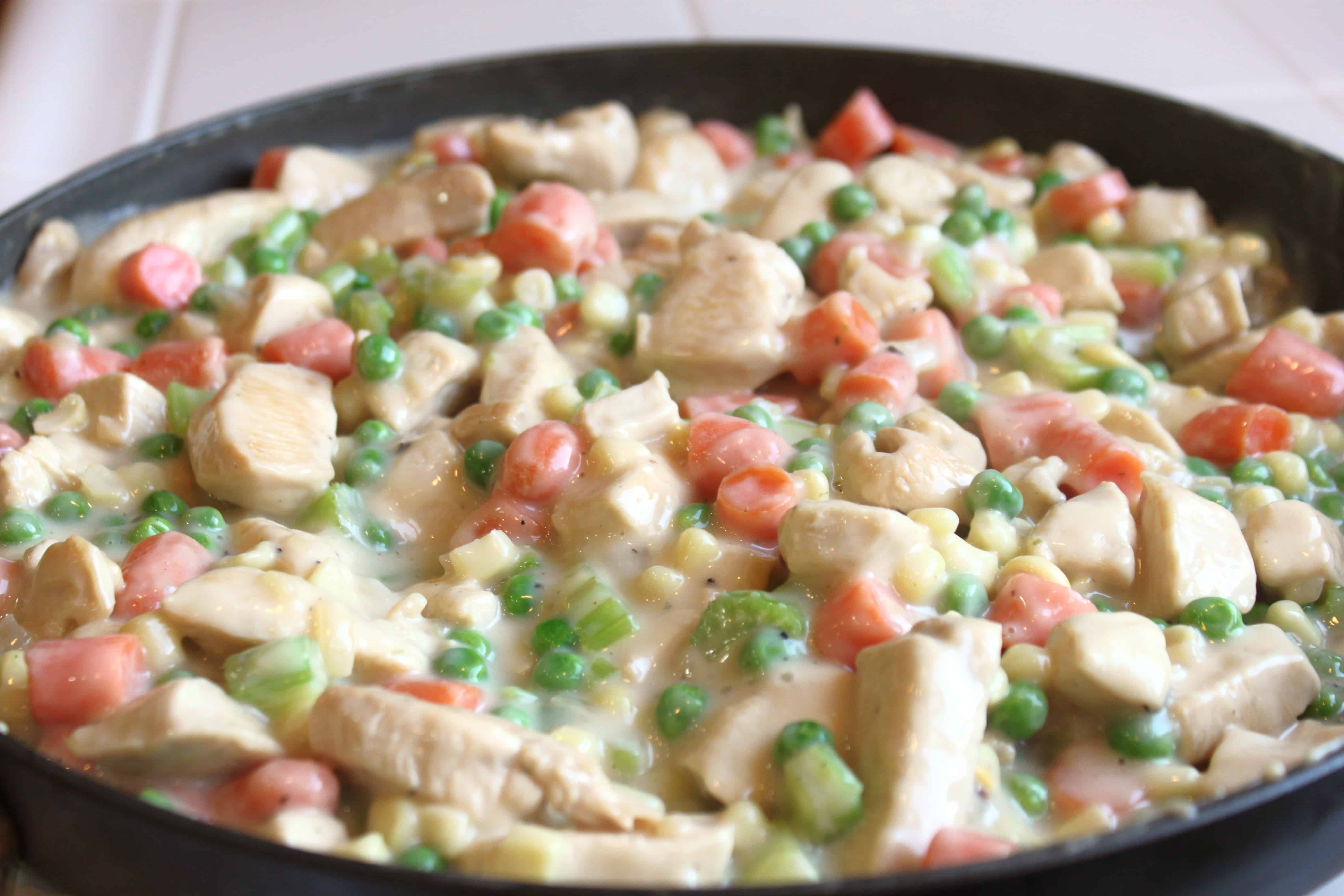
Grab These Ingredients for the Pot Pie Filling:
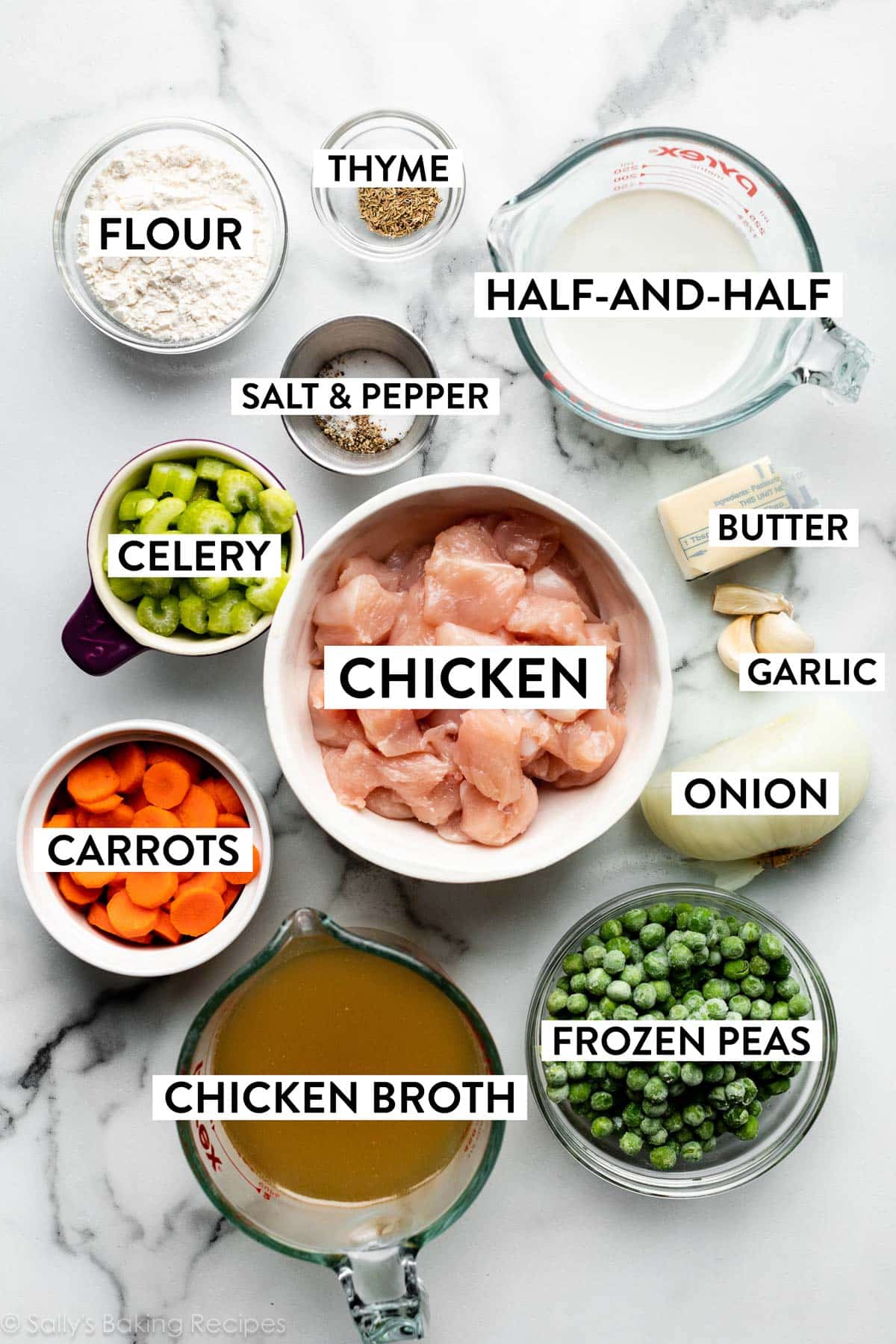
- Chicken: The recipe calls for uncooked boneless, skinless chicken breast, but you can absolutely make this with chicken thighs instead. You can also use pre-cooked chicken—see recipe Notes.
- Carrots & Celery: You’ll start by cooking these together with the chicken in a pot of boiling water, then drain.
- Butter, Onion, & Garlic: The aromatic flavor base for many sauces and soups, including creamy chicken noodle soup.
- Flour: Flour thickens the sauce.
- Seasonings: We’re flavoring this pot pie filling with salt, pepper, and thyme.
- Chicken Stock/Broth: Feel free to use vegetable broth/stock instead.
- Half-and-half: This is the magic ingredient for a rich, creamy sauce that coats the meat and vegetables in the pot pie filling.
- Frozen Peas: Here’s where you can mix things up and add the vegetables you love most or simply have on hand. I usually use frozen peas. No need to thaw or cook them, just add them directly into the pot pie. Add them at the end—if you cook them with the other vegetables and chicken, they’ll lose their vibrant green color and taste a little mushy.
These Step-by-Step Photos Will Help
Cook the chicken, carrots, and celery in a pot of boiling water, then drain. (See recipe Notes if using pre-cooked chicken.)
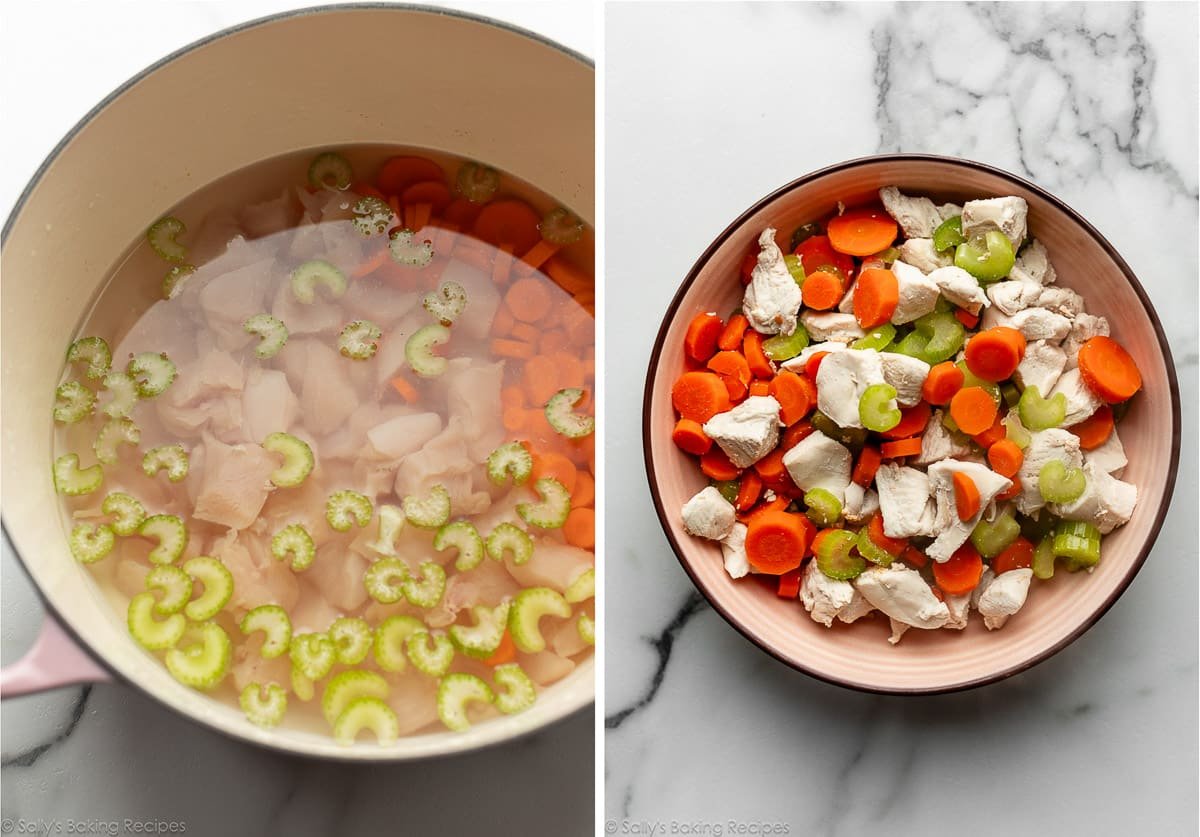
In a skillet or separate pan, cook down the onion and garlic in butter. Whisk in the flour, salt, pepper, and thyme. (Major flavor building is happening here!)

After the flour soaks up the moisture from the cooked vegetables, add the broth and half-and-half. Let everything simmer and thicken on the stove, stirring occasionally, until the sauce is a thick, gravy-like consistency.
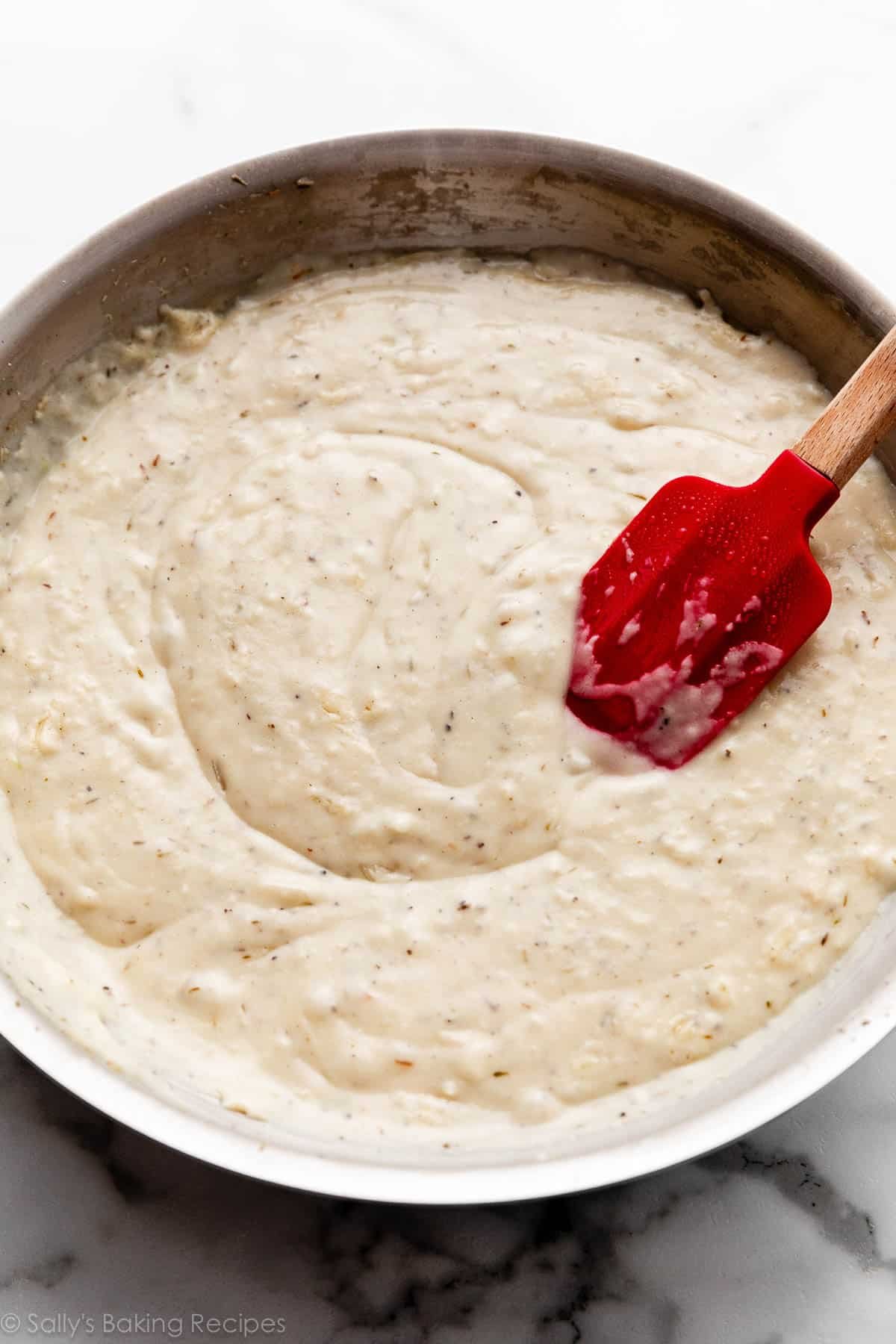
Roll out the first half of pie dough into a 12-inch circle, and fit it into your pie dish.
Add the cooked chicken and veggies, followed by the frozen peas, and pour/spread the gravy on top.
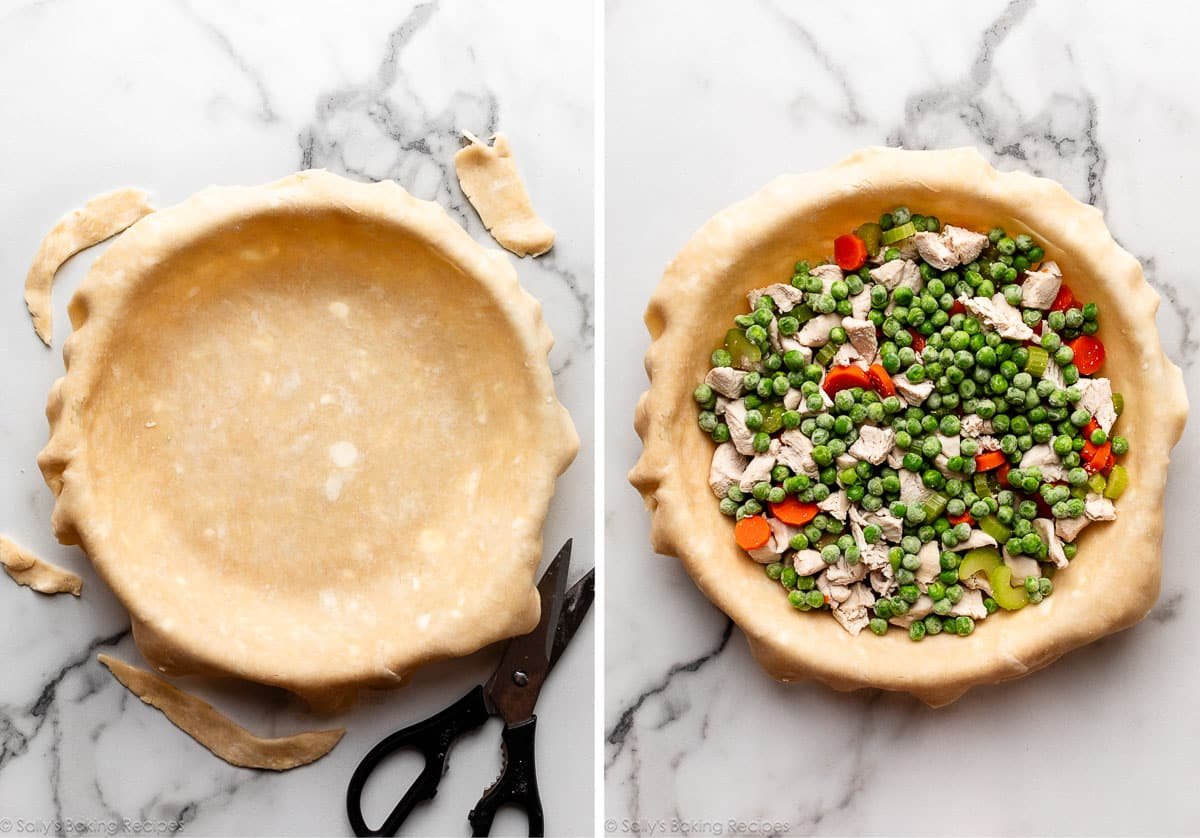

Roll out the second half of pie dough into a 12-inch circle, and lay it over the filling. Seal and crimp or flute the pie crust edges, then slice a few small slits in the top crust, to allow steam to escape.
Don’t forget the egg wash! The egg wash is what gives the crust its golden, glistening sheen. Without it, your pot pie will look a little dull. To make it, simply whisk 1 egg with 1 Tablespoon of milk (I just use a fork to whisk). You can use a pastry brush to brush the top crust and edges.
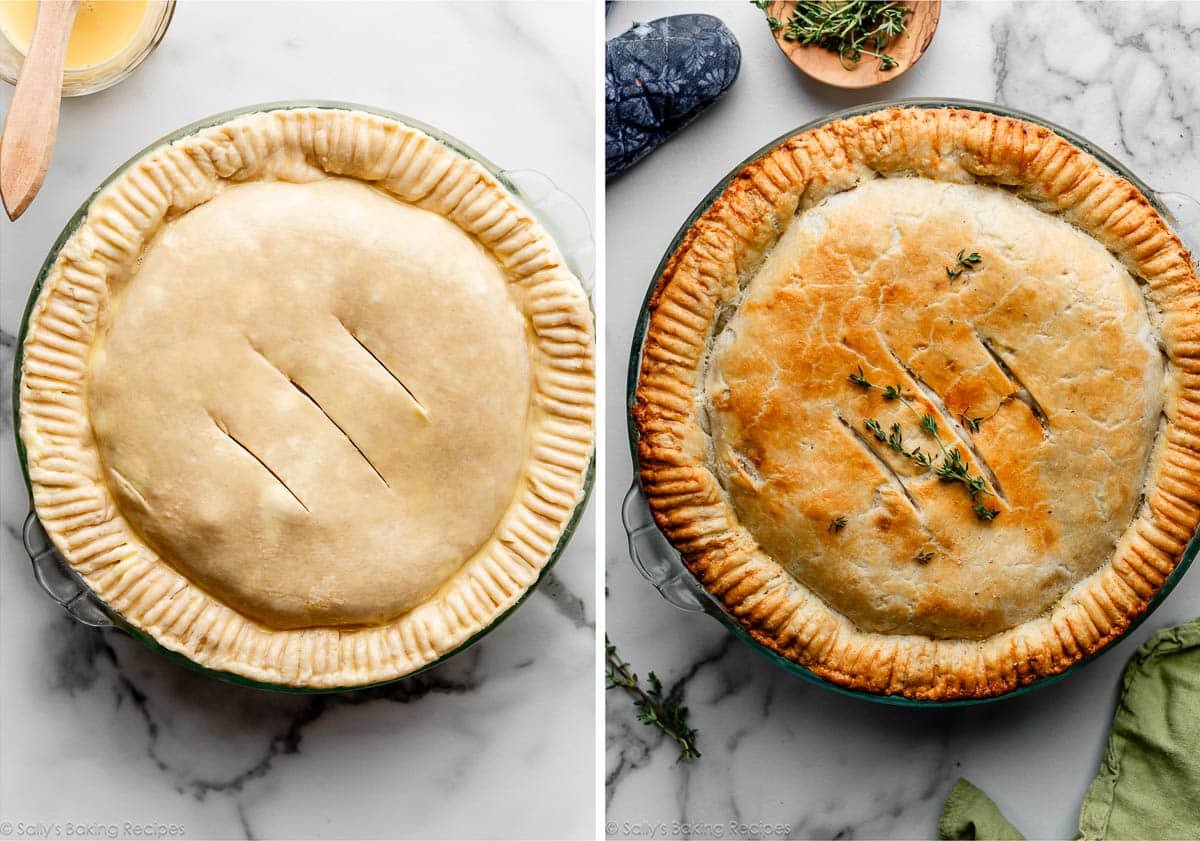
Bake in a hot oven (425°F (218°C)) until golden brown. The pot pie doesn’t take too long, because the filling is already cooked; you’re really just baking the pie crust and letting the filling ingredients and flavors mingle together.
The sauce in chicken pot pie is typically a gravy. I use a seasoned white gravy made from scratch with flavor-building ingredients, chicken broth, and half-and-half.
I have a trick for this! I add the filling ingredients including the chicken and vegetables first, and then pour the gravy on top. You’re not pouring the gravy directly on the bottom pie crust this way. The gravy seeps down slowly as the pot pie bakes, which gives the bottom crust some time to crisp up. Additionally, I recommend using a glass or metal pie dish for the best crust. Pies cooked at such a high temperature can bake unevenly in ceramic pie dishes.
Yes, absolutely. Skip adding the bottom pie dough to the pie dish and when the gravy is done and comes off heat, mix it with the chicken/carrot mixture, and then spoon into ungreased pie dish. I recommend lowering the oven temperature to 375°F (191°C) because there is just 1 crust to bake. Bake time is 35–40 minutes or until the top of the crust is golden brown. See my turkey pot pie recipe instructions—that recipe uses just 1 top crust.


Chicken Pot Pie Filling | Canuary 2022
FAQ
How do I thicken my chicken pot pie?
How can I make my pie filling thicker?
